
From 1935 until her death in 1966, Margery Allingham and her husband Philip Youngman Carter(“Pip”) lived at D’Arcy House in the Essex village of Tolleshunt D’Arcy, near Maldon, where they enjoyed what Margery’s sister Joyce described as “a life full of writing, art and village cricket”. The scraperboard drawing by Philip shows the front of D’Arcy House, and provided the frontispiece for his memoirs All I Did Was This.
The village provided the setting for some of Margery’s most interesting work, notably The Oaken Heart (1941), a lightly fictionalised account of the village’s experiences during the Second World War. Margery’s American publisher asked her to write it after he had been impressed by her letters telling him about wartime live in Tolleshunt D’Arcy. Although it was aimed mainly at American readers, it was more of a success in the UK.
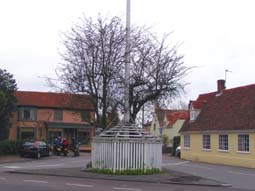
Tolleshunt D’Arcy – the maypole
© Chris Willis
The picture above shows the village square with its maypole, described by Margery on the opening page of The Oaken Heart. “The pole, which is only a pole, has a weathercock on top of it of it, and at its foot, where one waits for the bus, grow two may-trees, one red and one white, which the Old Doctors and Mrs Graves put there forty years ago.”
The yellow building is Forge Cottage, designed and built by Margery and Philip when the village forge became derelict. In the first chapter of The Oaken Heart she describes “Norry’s Forge, which has not been altered in the last hundred years at least … You never saw such ordered clutteredness, and when the fire is in full blast and he and his second eldest brother Jack (the Mycroft of the family) are at work there in their goatskin aprons, clinking and clanking on the largest anvil, which rings like a firebell all over the village, the effect, if they will forgive me for saying so, is quite extraordinarily reminiscent of the diamond mine scene in Snow White.”
Margery named some of the characters in her books after nearby villages, such as Tollesbury (Lord Tollesbury in “The Perfect Butler”), Coggeshall (Lord Coggeshall in “The Wink”) and Wivenhoe (Mr Wivenhoe in The Fashion in Shrouds and Stukely-Wivenhoe in Sweet Danger.)
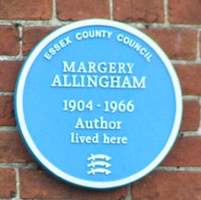
Blue Plaque
© Chris Willis
Margery’s home, D’Arcy House, now has a blue plaque commemorating her. The plaque was unveiled by Margery’s sister Joyce on 20th May 1992, which would have been Margery’s own 88th birthday.
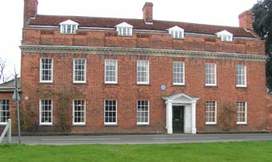
D’Arcy House, Tolleshunt D’Arcy,
Margery Allingham’s home
© Chris Willis
The house was previously owned by the local doctor, John Henry Salter (1841-1932), who wrote an eighty-volume diary about life in the village. He was a friend of Margery’s mother, Emily, and Margery had often visited the house as a child. Emily had hoped that Dr Salter would leave her the house in his will, but he did not. However, Margery and Pip were able to buy it when it was put up for sale a few years later.
The elegant Georgian house is privately owned, and is not open to the public.
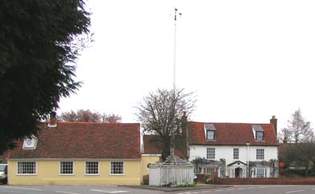
The Queen’s Head, Tolleshunt D’Arcy
© Chris Willis
Although it is only a small village, Tolleshunt D’Arcy boasts three pubs which, as Margery writes in The Oaken Heart “is plenty, since there are only six hundred of us.” She describes “the Queen’s Head, which stands back in its own yard with a great sign swinging on a rather nice post which the brewers put up,” “the Thatcher’s, kept by Norry’s brother Jack and his two sisters, Miss Vic and Miss Susie” and “the [Red] Lion … at the other end of the village on the way to the church”. A fourth pub, the Wheatsheaf, closed a few years before the First World War, and was sold by the Parish Council. The proceeds were used to build a row of council houses known as “Coronation Cottages”. Some money was left over which meant that, as Margery writes in The Oaken Heart “we’re not quite so beholden to the Rural District Council as we might be. Parochially, we have money in our purse.”

Margery & Philip in the front door of
D’Arcy House
D’Arcy house is on North Street, midway between the Red Lion and the Queen’s Head. The picture on the left shows Margery and Philip in the doorway of the house.
During the Second World War, Philip was abroad serving in the armed forces, but Margery remained at Tolleshunt D’Arcy, where she was active in organising civil defence and finding homes for evacuees. During this time she wrote The Oaken Heart, which aimed to show American readers how a typical English village coped in wartime.
After the war, Philip’s job meant that he and Margery divided their time between D’Arcy and London. But Margery always preferred D’Arcy.
One of the highlights of village life in the 1950s was the annual cricket match between the village and Philip’s London club, the Thursday Club. The club had been formed in 1946, and its members met weekly for lunch in a Soho oyster bar. Membership was limited to 25 people, and included well-known figures such as Peter Ustinov, Gilbert Harding and the Duke of Edinburgh. The match was held in June, in a field which was part of the extensive grounds of D’Arcy House.
The team who played on 18 June 1949 included a distinguished visitor – the Duke of Edinburgh. Margery and Philip had promised not to reveal the Duke’s identity until after the match had started. But one of the villagers spotted him at lunch and said to Margery, “Doesn’t that gentleman look exactly like the Duke of Edinburgh?” With great presence of mind, Margery calmly replied, “Yes, exactly like him!”
Margery’s sister Joyce took cine films of the cricket matches and other highlights of village life. She left these to the Univeristy of East Anglia’s East Anglian Film Archive in her will. Part of one film shows Margery baking bread for the cricketers’ lunch.
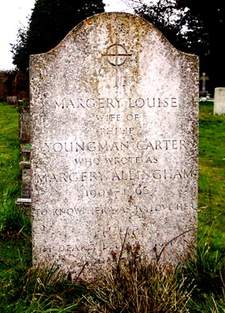
Margery Allingham’s grave
© Chris Willis
Margery Allingham’s grave is in the small graveyard on the opposite side of the road from the village church (at the junction with the road to Tolleshunt Major). The inscription reads:
MARGERY LOUISE
WIFE OF
PHILIP
YOUNGMAN CARTER
WHO WROTE AS
MARGERY ALLINGHAM
1904-1966
TO KNOW HER WAS TO LOVE HER
PHILIP
HER DEARLY BELOVED HUSBAND
1904-1969
